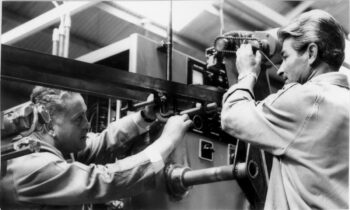
An important direct outcome of the Gumley, O’Halloran overseas trip in 1965 was the “discovery” of the Soudronic side-seam welding machine at a plant near Zurich, Switzerland.
After cabling comprehensive information on these exciting new welders, Frank O’Halloran anxiously awaited a response. The return cable duly came and being economical of each word (which cost money) Tyrrell’s reply was “Buy 3 get 5”.
It took O’Halloran a little while to work out what it meant. He eventually ordered three welders, asked for five percent discount which he duly received and the order was confirmed.
Frank brought this significant new welding technology to National Can and to Australia. The Soudronic welding process was a major step forward in world can making, enabling side seam welding of cans, a much better and more economical process than the previous methods of both lap and lock seam soldering. So important was this development that the name plates were removed from the Soudronic machines, so few knew their origin. This gave National Can an Australian monopoly of the new process for over twelve months.
The first cans seamed by this revolutionary process were made at Belmont, WA plant in the winter of 1965. It was a great achievement for the young company.
Not only was it a major innovation in the can industry but the welded seam aerosol can, developed by National Can, enhanced the competitive standing of tinplate cans among other forms of packaging.
Because of its welded seam technology, National Can was able to experiment with pilot runs of aerosol cans were produced at Meadowbank. The general use of aerosol cans occurred in mid-1965, with a rapid expansion in the UK, Europe and USA. US sales of aerosols topped 1 billion units in 1965.
National Can’s chief electrician Valdo Chelotti, developed single wire welding on Soudronic machines, a world’s first, later to be adopted by the Swiss machine maker.